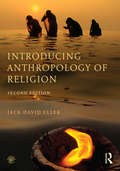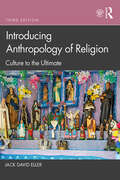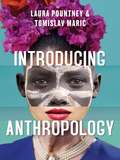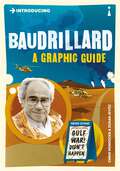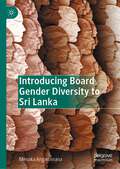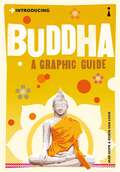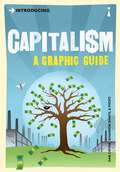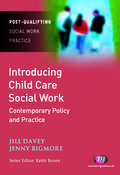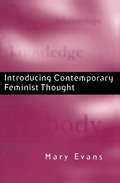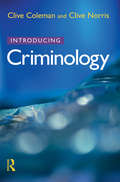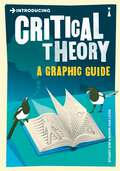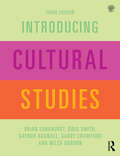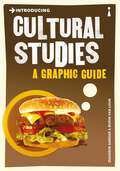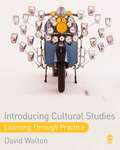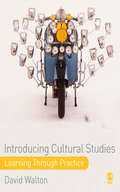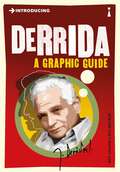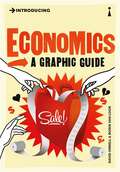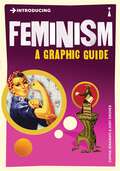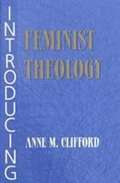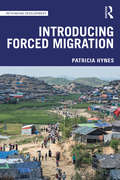- Table View
- List View
Introducing Anthropology of Religion: Culture to the Ultimate
by Jack David EllerThis clear and engaging guide introduces students to key areas of the field and shows how to apply an anthropological approach to the study of religion in the contemporary world. Written by an experienced teacher, it covers major traditional topics including definitions, theories and beliefs as well as symbols, myth and ritual. The book also explores important but often overlooked issues such as morality, violence, fundamentalism, secularization, and new religious movements. The chapters all contain lively case studies of religions practiced around the world. The second edition of Introducing Anthropology of Religion contains updated theoretical discussion plus fresh ethnographic examples throughout. In addition to a brand new chapter on vernacular religion, Eller provides a significantly revised chapter on the emerging anthropologies of Christianity and Islam. The book features more material on contemporary societies as well as new coverage of topics such as pilgrimage and paganism. Images, a glossary and questions for discussion are now included and additional resources are provided via a companion website.
Introducing Anthropology of Religion: Culture to the Ultimate
by Jack David EllerThis clear and engaging guide introduces students to key areas of the field and shows how to apply an anthropological approach to the study of religion in the contemporary world. Written by an experienced teacher, it covers major traditional topics including definitions, theories, and beliefs, as well as symbols, myth, and ritual. The book also explores important but often overlooked issues such as morality, violence, fundamentalism, secularization, and new religious movements. The chapters all contain lively case studies of religions practiced around the world. The third edition of Introducing Anthropology of Religion is fully updated and contains additional content on material religion, visual religion, and affect theory, and a new chapter takes a closer look at medical and health topics. The author encourages the reader to engage throughout with the unifying themes of race, gender, and power, and how these themes are intertwined with anthropology of religion. Images, a glossary, and questions for discussion are included and additional resources are provided via a companion website.
Introducing Anthropology of Religion: Culture to the Ultimate
by Jack David EllerThis clear and engaging guide introduces students to key areas of the field and shows how to apply an anthropological approach to the study of religion in the contemporary world. Written by an experienced teacher, it covers major traditional topics including definitions, theories, and beliefs, as well as symbols, myth, and ritual. The book also explores important but often overlooked issues such as morality, violence, fundamentalism, secularization, and new religious movements. The chapters all contain lively case studies of religions practiced around the world. The third edition of Introducing Anthropology of Religion is fully updated and contains additional content on material religion, visual religion, and affect theory, and a new chapter takes a closer look at medical and health topics. The author encourages the reader to engage throughout with the unifying themes of race, gender, and power, and how these themes are intertwined with anthropology of religion. Images, a glossary, and questions for discussion are included and additional resources are provided via a companion website.
Introducing Anthropology: What Makes Us Human? (PDF)
by Laura Pountney Tomislav MaricIntroducing Anthropology is the first book of its kind. It offers a serious but accessible introduction to anthropology and is the perfect starting point for anyone new to the subject. Across a series of fourteen chapters, it addresses the different fields and approaches within anthropology, covers an extensive range of themes, and emphasizes the role of anthropology in the world today. Written by two authors with a passion for teaching and a commitment to communicating the excitement of anthropology, the book has been carefully designed to support and extend students’ learning.
Introducing Baudrillard: A Graphic Guide (Introducing...)
by Chris HorrocksIllustrated guide to the controversial sociologist Jean Baudrillard, who died in 2007. Did the Gulf War take place? Is it possible to fake a bank robbery? Was sexual liberation a disaster? Jean Baudrillard has been hailed as one of France's most subtle and powerful theorists. But his provocative style and assaults on sociology, feminism and Marxism have exposed him to accusations of promoting a dangerous new orthodoxy - of being the 'pimp' of postmodernism. Introducing Baudrillard cuts beneath the controversy of this misunderstood intellectual to present his radical claims that reality has been replaced by a simulated world of images and events ranging from TV news to Disneyland. It provides a clear account of Baudrillard's work on obesity, pornography and terrorism and traces his development from critic of mass consumption to prophet of the apocalypse. Chris Horrocks' text and Zoran Jevtic?s artwork invite us to decide whether Baudrillard was a cure for the vertigo of contemporary culture - or one of its symptoms
Introducing Board Gender Diversity to Sri Lanka
by Menaka AngammanaThrough a socio-legal lens, this book focuses on the feasibility of implementing board gender diversity rules in Sri Lanka. It demonstrates that board gender diversity rules could be a valuable tool for corporate governance development and to promote gender equality in society.The International Financial Institutions (IFIs) have reasoned that good corporate governance practices can develop the economy by attracting investors and securing foreign direct investment. Accordingly, these IFIs have included corporate governance reform as a condition for funding to developing countries. Among these reforms, board gender diversity is acknowledged as a legal concept that is capable of improving corporate governance practices and promoting gender equality in society. The benefits to corporate governance, often referred to as the economic benefits of the concept, are based on the contribution women directors can make towards advancing board effectiveness. The equality benefits underpinning this strategy depict the manner in which gender equality could be promoted by board gender diversity rules.Sri Lanka is thus an illustrative example of a developing country forced by IFIs to improve its corporate governance practices as a step towards advancing economic growth. However, the Sri Lankan legislators have not yet introduced board gender diversity rules as a measure to improve corporate governance practices within the country. This book addresses some of the ways in which board gender diversity rules could be introduced to Sri Lanka.
Introducing Buddha: A Graphic Guide (Introducing...)
by Borin Van Loon Jane HopeMeditation, Karma, Zen, Tantric and Nirvana are some of the many Buddhist ideas Westerners hear of frequently, even if their meaning has been lost in translation. This vast and complex non-theistic religion is woven into the fabric of Asian civilisations. from India to the Himalayan regions, China, Vietnam, Korea, Japan and elsewhere. What is Buddhism really all about? Introducing Buddha describes the life and teachings of the Buddha, but it also shows that enlightenment is a matter of experiencing the truth individually, and by inspiration which is passed from teacher to student. Superbly illustrated by Borin Van Loon, the book illuminates this process through a rich legacy of stories, explains the practices of meditation, Taoism and Zen, and goes on to describe the role of Buddhism in modern Asia and its growing influence on Western thought.
Introducing Capitalism: A Graphic Guide (Introducing...)
by Sharron Shatil Dan CryanCapitalism now dominates the globe, both in economics and ideology, shapes every aspect of our world and influences everything from laws, wars and government to interpersonal relationships. Introducing Capitalism tells the story of its remarkable and often ruthless rise, evolving through strife and struggle as much as innovation and enterprise. Dan Cryan and Sharron Shatil, with Piero's brilliant graphics, cover the major economic, social and political developments that shaped the world we live in, such as the rise of banking, the founding of America and the Opium Wars.The book explores the leading views for and against, including thinkers like Adam Smith, Karl Marx, Theodor Adorno and Milton Friedman, the connections between them and their historical context. Few ideas have had as much impact on our everyday lives as capitalism. Introducing Capitalism is the essential companion.
Introducing Child Care Social Work: Contemporary Policy and Practice (PDF) (Post-Qualifying Social Work Practice Series)
by Jill Davey Jennifer BigmoreThis book provides a practitioner′s perspective on the challenges and developments of working in Child Care Social Work in the current context of organisational and social change. Drawing on the experience of social work practitioners who have undertaken the Post-Qualifying Child Care Specialist Award, the book shows how these challenges are being met in everyday practice, providing a forum to share their knowledge and experience with others and contribute to best practice. It will be of interest to social work practitioners and students and all those interested in the reality of current child care practice.
Introducing Child Care Social Work: Contemporary Policy and Practice (Post-Qualifying Social Work Practice Series)
by Jill Davey Jennifer BigmoreThis book provides a practitioner′s perspective on the challenges and developments of working in Child Care Social Work in the current context of organisational and social change. Drawing on the experience of social work practitioners who have undertaken the Post-Qualifying Child Care Specialist Award, the book shows how these challenges are being met in everyday practice, providing a forum to share their knowledge and experience with others and contribute to best practice. It will be of interest to social work practitioners and students and all those interested in the reality of current child care practice.
Introducing Contemporary Feminist Thought
by Mary EvansThis introductory textbook offers a concise and lucid account of the main developments in contemporary feminist thinking, and demonstrates the centrality of feminist thought to all areas of intellectual enquiry. In a wide-ranging discussion, Evans argues that most accounts of the world since the Enlightenment have been constructed in terms of a distinction between the public and the private which excluded women. Using both historical and more recent examples, she examines the breadth and complexity of feminist thinking, focusing on key themes such as the body, representation, engendering knowledge, and the relationship between women and the state. Evans argues that feminist thought seeks less to add to existing theory than to re-theorize the social and symbolic worlds; no contemporary account of these worlds, she suggests, is complete without a discussion of the implications of gender difference. This book offers a clear and coherent guide to contemporary feminism for students of women's studies, gender studies, sociology, social theory and literary theory.
Introducing Contemporary Feminist Thought
by Mary EvansThis introductory textbook offers a concise and lucid account of the main developments in contemporary feminist thinking, and demonstrates the centrality of feminist thought to all areas of intellectual enquiry. In a wide-ranging discussion, Evans argues that most accounts of the world since the Enlightenment have been constructed in terms of a distinction between the public and the private which excluded women. Using both historical and more recent examples, she examines the breadth and complexity of feminist thinking, focusing on key themes such as the body, representation, engendering knowledge, and the relationship between women and the state. Evans argues that feminist thought seeks less to add to existing theory than to re-theorize the social and symbolic worlds; no contemporary account of these worlds, she suggests, is complete without a discussion of the implications of gender difference. This book offers a clear and coherent guide to contemporary feminism for students of women's studies, gender studies, sociology, social theory and literary theory.
Introducing Criminology
by Clive Coleman Clive NorrisCriminology, or the study of crime, has developed rapidly as a subject in recent years, while crime and the problem of how to respond to it have become major concerns for society as a whole. This book provides a succinct, highly readable - and much needed - introduction to criminology for those who want to learn more, whether they are already studying the subject, thinking of doing so, or just interested to discover what criminology is about. Introducing Criminology begins by asking basic questions: what is crime? what is criminology?, before examining the ways in which crime has been studied, and looking at the main approaches and schools of thought within criminology and how these have been developed. The authors focus particularly upon attempts to understand and explain crime by the disciplines of psychology and sociology, and consider also the impact of feminist and postmodern thought on the development of the subject. In the second part of the book the authors take three very different topics to illustrate themes raised in the first half of the book, exploring the particular issues raised by each topic, and showing how criminologists have gone about their work.
Introducing Criminology
by Clive Coleman Clive NorrisCriminology, or the study of crime, has developed rapidly as a subject in recent years, while crime and the problem of how to respond to it have become major concerns for society as a whole. This book provides a succinct, highly readable - and much needed - introduction to criminology for those who want to learn more, whether they are already studying the subject, thinking of doing so, or just interested to discover what criminology is about. Introducing Criminology begins by asking basic questions: what is crime? what is criminology?, before examining the ways in which crime has been studied, and looking at the main approaches and schools of thought within criminology and how these have been developed. The authors focus particularly upon attempts to understand and explain crime by the disciplines of psychology and sociology, and consider also the impact of feminist and postmodern thought on the development of the subject. In the second part of the book the authors take three very different topics to illustrate themes raised in the first half of the book, exploring the particular issues raised by each topic, and showing how criminologists have gone about their work.
Introducing Critical Theory: A Graphic Guide (Introducing... #0)
by Professor Stuart SimWhat might a 'theory of everything' look like? Is science an ideology? Who were Adorno, Horkheimer or the Frankfurt School? The decades since the 1960s have seen an explosion in the production of critical theories. Deconstructionists, poststructuralists, postmodernists, second-wave feminists, new historicists, cultural materialists, postcolonialists, black critics and queer theorists, among a host of others, all vie for our attention. Stuart Sim and Borin Van Loon's incisive graphic guide provides a route through the tangled jungle of competing ideas and provides an essential historical context, situating these theories within tradition of critical analysis going back to the rise of Marxism. They present the essential methods and objectives of each theoretical school in an incisive and accessible manner, and pay special attention to recurrent themes and concerns that have preoccupied a century of critical theoretical activity.
Introducing Cultural Studies
by Brian Longhurst Greg Smith Gaynor Bagnall Garry Crawford Miles OgbornThis updated, new edition of Introducing Cultural Studies provides a systematic and comprehensible introduction to the concepts, debates and latest research in the field. Reinforcing the interdisciplinary nature of Cultural Studies, the authors first guide the reader through cultural theory before branching out to examine different dimensions of culture in detail – including globalisation, the body, geography, fashion, and politics. Incorporating new scholarship and international examples, this new edition includes: New and improved 'Defining Concepts', 'Key Influences', 'Example ', and 'Spotlight' features that probe deeper into the most significant ideas, theorists and examples, ensuring you obtain an in-depth understanding of the subject. A brand new companion website featuring a flashcard glossary, web links, discussion and essay questions to stimulate independent study. A new-look text design with over 60 pictures and tables draws all these elements together in an attractive, accessible design that makes navigating the book, and the subject, simple and logical. Introducing Cultural Studies will be core reading for Cultural Studies undergraduates and postgraduates, as well as an illuminating guide for those on Communication and Media Studies, English, Sociology, and Social Studies courses looking for a clear overview of the field.
Introducing Cultural Studies
by Brian Longhurst Greg Smith Gaynor Bagnall Garry Crawford Miles OgbornThis updated, new edition of Introducing Cultural Studies provides a systematic and comprehensible introduction to the concepts, debates and latest research in the field. Reinforcing the interdisciplinary nature of Cultural Studies, the authors first guide the reader through cultural theory before branching out to examine different dimensions of culture in detail – including globalisation, the body, geography, fashion, and politics. Incorporating new scholarship and international examples, this new edition includes: New and improved 'Defining Concepts', 'Key Influences', 'Example ', and 'Spotlight' features that probe deeper into the most significant ideas, theorists and examples, ensuring you obtain an in-depth understanding of the subject. A brand new companion website featuring a flashcard glossary, web links, discussion and essay questions to stimulate independent study. A new-look text design with over 60 pictures and tables draws all these elements together in an attractive, accessible design that makes navigating the book, and the subject, simple and logical. Introducing Cultural Studies will be core reading for Cultural Studies undergraduates and postgraduates, as well as an illuminating guide for those on Communication and Media Studies, English, Sociology, and Social Studies courses looking for a clear overview of the field.
Introducing Cultural Studies: A Graphic Guide (Introducing...)
by Ziauddin SardarCultural Studies signals a major academic revolution for the 21st century. But what exactly is it, and how is it applied? It is a discipline that claims not to be a discipline; it is a radical critical approach for understanding racial, national, social and gender identities. "Introducing Cultural Studies" provides an incisive tour through the minefield of this complex subject, charting its origins in Britain and its migration to the USA, Canada, France, Australia and South Asia, examining the ideas of its leading exponents and providing a flavour of its use around the world. Covering the ground from Gramsci to Raymond Williams, postcolonial discourse to the politics of diaspora, feminism to queer theory, technoculture and the media to globalization, it serves as an insightful guide to the essential concepts of this fascinating area of study. It is essential reading for all those concerned with the quickening pulse of old, new and emerging cultures.
Introducing Cultural Studies: Learning through Practice
by David Walton"An outstanding entry level text aimed at those with little or no cultural studies knowledge... Innovative, creative and clever." - Times Higher Education "The ideal textbook for FE and first year HE cultural studies students. Its quality and character allow the reader to ‘feel’ the enthusiasm of its author which in turn becomes infectious, instilling in the reader a genuine sense of ebullient perturbation." - Art/Design/Media, The Higher Education Authority An introduction to the practice of cultural studies, this book is ideal for undergraduate courses. Full of practical exercises that will get students thinking and writing about the issues they encounter, this book offers its readers the conceptual tools to practice cultural analysis for themselves. There are heuristics to help students prepare and write projects, and the book provides plenty of examples to help students develop their own ideas. Written in a creative, playful and witty style, this book: Links key concepts to the key theorists of cultural studies. Includes a wide range of references of popular cultural forms. Emphasizes the multidisciplinary nature of cultural studies. Includes pedagogical features, such as dialogues, graphs, images and recommended readings. The book′s skills-based approach enables students to develop their creative skills, and shows students how to improve their powers of analysis generally.
Introducing Cultural Studies: Learning through Practice
by David Walton"An outstanding entry level text aimed at those with little or no cultural studies knowledge... Innovative, creative and clever." - Times Higher Education "The ideal textbook for FE and first year HE cultural studies students. Its quality and character allow the reader to ‘feel’ the enthusiasm of its author which in turn becomes infectious, instilling in the reader a genuine sense of ebullient perturbation." - Art/Design/Media, The Higher Education Authority An introduction to the practice of cultural studies, this book is ideal for undergraduate courses. Full of practical exercises that will get students thinking and writing about the issues they encounter, this book offers its readers the conceptual tools to practice cultural analysis for themselves. There are heuristics to help students prepare and write projects, and the book provides plenty of examples to help students develop their own ideas. Written in a creative, playful and witty style, this book: Links key concepts to the key theorists of cultural studies. Includes a wide range of references of popular cultural forms. Emphasizes the multidisciplinary nature of cultural studies. Includes pedagogical features, such as dialogues, graphs, images and recommended readings. The book′s skills-based approach enables students to develop their creative skills, and shows students how to improve their powers of analysis generally.
Introducing Derrida: A Graphic Guide (Introducing... #0)
by Jeff CollinsBrilliant illustrated guide to the best-known and most controversial continental philosopher of the latter 20th century. Jacques Derrida is the most famous philosopher of the late 20th century. Yet Derrida has undermined the rules of philosophy, rejected its methods, broken its procedures and contaminated it with literary styles of writing. Derrida's philosophy is a puzzling array of oblique, deviant and yet rigorous tactics for destabilizing texts, meanings and identities. 'Deconstruction', as these strategies have been called, is reviled and celebrated in equal measure. Introducing Derrida introduces and explains his work, taking us on an intellectual adventure that disturbs some of our most comfortable habits of thought.
Introducing Economics: A Graphic Guide (Introducing...)
by David OrrellA comic-book introduction to economics from David Orrell, the author of Economyths: 11 Ways Economics Gets it Wrong. With illustrations from Borin Van Loon. Part of the internationally-recognised Introducing Graphic Guide series. Today, it seems, all things are measured by economists. The so-called 'dismal science' has never been more popular - or, given its failure to predict or prevent the recent financial crisis, more controversial. But what are the findings of economics? Is it really a science? And how can it help our lives? Introducing Economics traces the history of the subject from the ancient Greeks to the present day. Orrell and Van Loon bring to life the contributions of great economists - such as Adam Smith, Karl Marx, John Maynard Keynes and Milton Friedman - and delve into ideas from new areas such as ecological and complexity economics that are revolutionizing the field.
Introducing Feminism: A Graphic Guide (Introducing...)
by Cathia JenainatiThe term 'feminism' came into English usage around the 1890s, but women's conscious struggle to resist discrimination and sexist oppression goes much further back. This completely new and updated edition of "Introducing Feminism" surveys the major developments that have affected women's lives from the 17th century to the present day. "Introducing Feminism" is an invaluable reference book for anyone seeking the story of how feminism reconfigured the world for women and men alike.
Introducing Feminist Theology (PDF)
by Anne M. CliffordIntroducing Feminist Theology responds to the questions What is feminist theology? and Why is it important? by considering the perspectives of women from around the globe who have very diverse life experience and relationships to God, Church and creation. Clifford introduces the major forms of feminist theology: radical, reformist, and reconstructionist, and highlights some of their specific characteristics.
Introducing Forced Migration (Rethinking Development)
by Patricia HynesAt a time when global debates about the movement of people have never been more heated, this book provides readers with an accessible, student-friendly guide to the subject of forced migration. Readers of this book will learn who forced migrants are, where they are and why international protection is critical in a world of increasingly restrictive legislation and policy. The book outlines key definitions, ideas, concepts, points for discussion, theories and case studies of the various forms of forced migration. In addition to this technical grounding, the book also signposts further reading and provides handy Key Thinker boxes to summarise the work of the field’s most influential academics. Drawing on decades of experience both in the classroom and in the field, this book invites readers to question how labels and definitions are used in legal, policy and practice responses, and to engage in a richer understanding of the lives and realities of forced migrants on the ground. Perfect for undergraduate and postgraduate teaching in courses related to migration and diaspora studies, Introducing Forced Migration will also be valuable to policy-makers, practitioners, journalists, volunteers and aid workers working with refugees, the internally displaced and those who have experienced trafficking.
